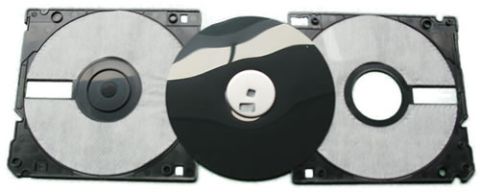In the early eighties, the problem crystallized that the five quarter inch floppy disk, which actually was just designed as a smaller version of the eight inch floppy
disk, was too big.
By improving the recording technique it was possible to save the same amount of data on a much smaller space. In addition, the weaknesses of the old eighth variant in the transport sector were being revealed.
For example, damage happened easily because of the thin shell of the disk or through the usual practice of the "memory change" for double sided writing, the
storage surface became very dirty.

Because of these problems various solutions followed by some companies. They developed disks with size of two up to three a half inch.
Solely by the large variation between different providers, none of the formats were initially really successful on the market.
However, almost all had a dirt defense mechanism and a harder shell in common.
The breaktrought in this turmoil finally suceeded in 1984 by Sony in convincing Apple of their three and a half-inch version.
Apple then built-in such a drive in the Macintosh 128k. The future standard of a three and a half inch drive resulted from that persuasion.